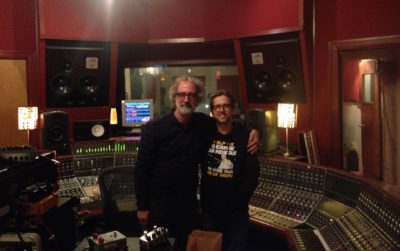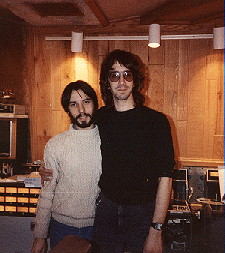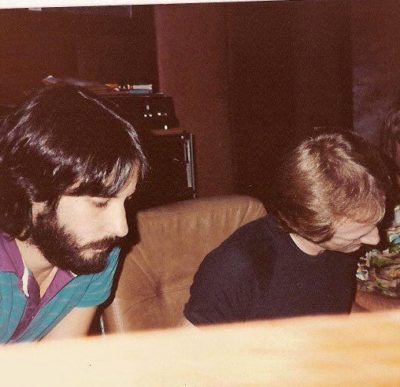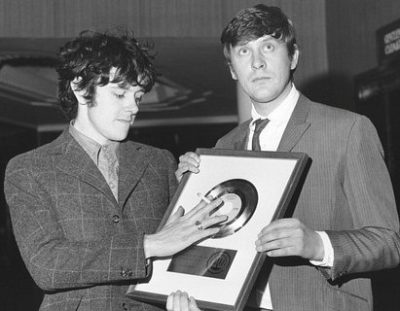A Chain of Mentorship: One Producer Traces Back His Chain of Audio Mentors 4 Generations
men·tor
ˈmenˌtôr,ˈmenˌtər
noun
1.
an experienced and trusted adviser.
2. adviser, guide, guru, counselor, consultant; confidant(e)
I first met the man who would become my mentor in March of 2015, when John Agnello, producer and engineer for Sonic Youth, Dinosaur Jr., Kurt Vile, Patti Smith and so many other artists I love, was hired to mix an album I had produced with Jeffrey Lewis at my own studio, SpeakerSonic.
Having the chance to peer over John’s shoulder and listen to him work in a perfect mixing environment was an exciting experience. He’s chill, down to earth and very good at what he does.
While bouncing some stems, we had the chance to shoot the breeze, and he spoke with excitement about the craft of recording and about his own mentor, a great engineer named William Wittman.
Since John was complimentary of my sounds, and had asked me about a few of the mic choices I had made, I took a chance to interject that I could use a mentor. Since then, I’ve sat in with John on a half-dozen mix projects in studios from Fluxivity in Brooklyn, to Water Music in Hoboken to the recently defunct Magic Shop.

The author Brian Speaker (pictured at right) with mentor John Agnello at The Magic Shop. He traces his a chain of mentorship back 50 years, all the way to legendary producer Mickie Most.
I still look forward to every opportunity that presents itself to see John’s workflow, to check out his settings on outboard gear and wrap my head around his session layout on his preferred Neve consoles.
John rolls around his own gear in two rolling rack units along with a few bins of preamps, pedals and tape delays. He is an alchemist when he works.
Experience is what a mentor brings to the relationship. John is one to experiments with tones, toys and delay times, and his spirit of trying things out brings a freshness to the process of recording and mixing and has informed my approach and attitude in ways I’ll never forget.
John doesn’t gain anything from letting me sit in on his mixes. He doesn’t have to let me in the door. But he does, and I absorb as much as I can at every moment. I will occasionally ask questions when there’s an opportunity and he is cordial and kind enough to give me his insight. Sometimes it’s as simple as, “I don’t know the numbers, I just like the way it sounds.”
On one occasion I asked about mixing low end, specifically, the bass and kick drum. He said, “Make the kick sound kick ass and then make the bass sound kick ass. And then put them together. There’s no formula, it’s not a science.”
Some of the things I’ve taken away from my experience with John are how to approach the snare sound and get the right blend from top to bottom, how to add fuzz to a bass, and to have different compressors and effect sends available and ready to go on my console during mixdown so I can test drive them on a whim before figuring out what works best.
John has picked up a few “kids”, as he calls them, along the way. He’s happy to be a mentor to the likes of myself and many others. “I could never not be like that,” he says. “It’s so ingrained in my DNA of being raised that you always reach out.”
But what a mentor brings to a relationship is more than just advice on sound.
“I was taught very early on these 3 important things,” John says: “Keep your eyes open, keep your ears open, and keep your mouth closed as much as possible. Pay attention, pay attention, pay attention. I feel like if you look and listen and watch all the time what your guy is doing, you’ll pick up way more stuff.”
Mentorship is a Chain
John’s own mentor is the GRAMMY award-winning producer/engineer, William Wittman, who has worked with Cyndi Lauper, Joan Osbourne, Mick Jagger and Bob Dylan, among others. Their relationship is playful, and in an ever-changing music industry, unique.
Agnello and Wittman met at the Record Plant where John started out as an intern, moving his way up through the ranks from assistant to engineer to becoming a producer in his own right. There, he worked under the tutelage of Mr. Wittman and a list of other excellent engineers and producers including Jack Douglas, Rod O’Brien, David Thoener, Jay Massina and Shelly Yakus.
Some of the things John took away from his experience with Wittman were his mic choices and placement for snare and guitar sounds, and his approach to 2-buss processing.
“When I was assisting for him, he would strap the ADR Compex on the stereo buss,” John explains.” [Since] I was old enough to buy one in 1988, I basically have strapped an ADR Compex on the stereo buss for almost every session I’ve done.
“I still, 30 years later, carry a lot of what I learned from him in what I do. It’s like my basic recording DNA, and even now my producing DNA, comes a lot from watching him do stuff. I mean he is just an amazing technical talent. A great engineer, a great producer—he’s super musical.”
Like so many new engineers today, Wittman didn’t have a mentor in the early part of his career. “I mostly back-doored my way into recording by watching my own band get recorded, and being the one interested in the process,” he says.
“By observing and asking questions I eventually found myself recording my own band and [friends’s bands] until I started to get calls [for]fill-in work doing overdubs for other people.”
At that time, Wittman’s workflows and gear choices were discoveries by “experimenting and fiddling until I found what I like.” If he saw how someone else got a great sound, he’d become adept to trying it out. If it worked for him, he’d keep it.
“We always tried to have fun in the studio,” Wittman says. “If you can’t enjoy getting to make records for a living, there’s something really wrong.
“John—probably because he was the young kid in the room—got sort of tortured a lot,” he says. “One thing I remember doing to him was, just as he would hit the record button to do a drop in on the tape machine, I would solo the snare drum so that the visceral feeling he’d inevitably get was one of panic that he’d ‘erased’ everything.”
Their working relationship has led them to a lifelong friendship. They still meet up from time to time for dinner and drinks.
At some point, Wittman must have realized the limitations to re-inventing the wheel, and now cites his “biggest source of inspiration” as a producer to his own mentor, Mike Chapman.
With Mike, Wittman says he learned “how to be in control of the timing and tone of a session. How to be the inspiring team leader. And how to fill the gaps that needed to be filled, whatever they [are]. How to never give up when you know and feel something can be better.”
Wittman met the man who would become his mentor while Chapman was on the lookout for a new freelance engineer to work with. Chapman felt good chemistry with Wittman, liked his previous work, and went on “instinct”. The two shared their time together working in studios like Record Plant, Electric Lady, Atlantic and Sound City, on projects for The Kind, Pat Benatar and Lita Ford. Wittman engineered while Chapman produced.
I caught up with Chapman, and Australian producer and hit songwriter for artists like Blondie, The Knack, Tina Turner and Pat Benatar and asked him about his experience in being a mentor to Wittman.
They first worked together on some sessions for the band Scandal at the Record Plant in 1980s NYC. Chapman describes Bill Wittman as “…a joy to work with.”
“Hard working, intelligent, knowledgeable, very musical, great ear and most of all very, very funny! We had many amusing moments, all at the expense of the artist! I have never aloud myself to show how incredibly anxious I am when I am in charge of making a record that will make or break and artist. I keep it light and fun. Only I know exactly how I feel.”
Chapman, in turn, had his own mentor, the English music producer, Mickie Most, who made an unforgettable name for himself in music production history working with The Animals, Herman’s Hermits, Suzi Quatro, Jeff Beck and many more.
The two worked together from 1970 through 1980 and Chapman credits his education as a producer to those first five years. Mickie took him “under his wing” and asked him “to hang out in the studio with him and observe.”
In those days, being in the studio was all about producing the hit single. Mickie Most taught him about working with orchestras and the many intricacies of producing a hit. But Chapman also learned, “how to make records and how not to make records,” explaining that Mickie was one to replace a band members performance with a session player in order to speed up the process. “To Mickie, the artist was nothing but a tool. Most of the time they annoyed him.”
When I asked Mr. Chapman what his advice to a young producer or engineer might be, he said, “don’t do it unless you are prepared to sacrifice everything for success.”
“It won’t work if you are half-assed or are not born with the gift. Know your strengths and your weaknesses. Don’t push the artist around, and always listen to the artist! You will learn a lot if you do. Remember, it’s not your record. It’s theirs. You are hired help. Never forget that!”
The business of recording is all about listening. From John Agnello, to William Wittman, to Mike Chapman, there is a lineage of teaching, sharing and learning.
Each of these talented and experienced audioworkers learned about recording and about how to handle artists and let their voices be heard, not only by doing, but by emulating the best habits of their mentors and trying to avoid the worst of them.
The settings, the gear, the engineering ability, all of these are simply tools to serve the artist and the music. To elevate them both to their full potential, it helps to stand on the shoulders of those who came before.
Please note: When you buy products through links on this page, we may earn an affiliate commission.









